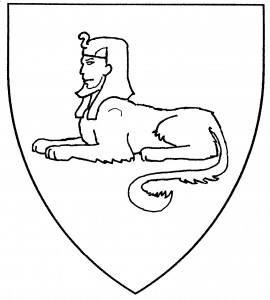The sphinx is a monster from ancient myth, with a lion’s body and a human head. There are two forms of this monster, the Greek form and the Egyptian form, both of which date from antiquity.
The Greek sphinx (the riddling monster slain by Oedipus) is winged, and has a woman’s head and breasts; it’s the more common form, and the only form found in period heraldry. Blazoned simply as a “sphinx” in period, it is sometimes blazoned in the Society as a “winged” or a “gyno-sphinx” (gyno, “woman”). The Greek sphinx was described in period tracts [Bossewell II.46], and was granted as a crest to Robert Parris in 1573 [Dennys 118].
The Egyptian sphinx is the monster whose statue is seen at Giza; it has a man’s head, wearing a pharaonic headdress, and has no wings. It’s sometimes blazoned an “andro-sphinx” (andro, “man”) in the Society. Though the statue was known, the Egyptian sphinx doesn’t seem to have been used in period armory.
Of course, Society armorists take pleasure in conflating the two forms, and examples of “Greek andro-sphinxes” and “Egyptian gyno-sphinxes” have been registered. Go figure.
Neither form of sphinx has a default posture in Society heraldry; the illustrations show a Greek sphinx sejant and an Egyptian sphinx couchant. For related charges, see chimera (German), lamia, manticore, man-tyger.
Ariadne Leontodes bears: Argent, a Greek sphinx rampant azure winged sable.
Eirene Korinthia bears: Purpure, a Greek sphinx sejant Or.
Khalil el-Hadji bears: Or, an Egyptian sphinx couchant azure between in chief two scimitars inverted, blades to center sable.
Mammarra Liona of Egypt bears: Azure, an Egyptian gyno-sphinx rampant Or.

